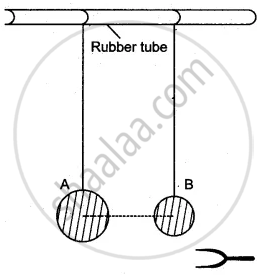Advertisements
Advertisements
प्रश्न
Explain free and forced vibrations. Give an experimental arrangement to illustrate the phenomenon of resonance.
उत्तर
When a system or a body vibrates without receiving impulses from another system or body, its vibrations are said to be free vibrations. However, when a system or body vibrates on account of impulses received from another system or body, the vibrations are called forced vibrations. In such a case the body or the system vibrates with the frequency of the impulses received and not with its natural frequency.

Experiment Arrangement to illustrate Resonance: In the figure, the two pendulums have exactly equal lengths. However, the bob of the pendulum A is heavier. Displace the bob of the pendulum A by a little distance in a direction perpendicular to the plane containing the two pendulums. Then release the bob. The pendulum A will begin to oscillate. After a short while, you will find that the pendulum B also begins to vibrate. Note that the two pendulums have the same frequency. The pendulum A through the rubber tube applies impulses of the same frequency on the pendulum B Hence, the pendulum B begins to vibrate.
APPEARS IN
संबंधित प्रश्न
When a troop crosses a suspension bridge, the soldiers are asked to break steps. Explain the reason.
When acoustic resonance takes place, a loud sound is heard. Why does this happen? Explain.
Explain why does the rear mirror of a motorbike start Vibrating Violently, at some particular speed of motorbike?
A vibrating tuning fork is placed over the mouth of a burette filled with water. The tap is opened and the water level gradually falls. It is observed that the sound becomes the loudest for a particular length of the air column. What is the name of the phenomenon taking place when this happens? Why does the sound become the loudest?
When a tuning fork, struck by a rubber pad, is held over a length of the air column in a tube, it produces a loud sound for a fixed length of the air column. Name the above phenomenon. How does the frequency of the loud sound compare with that of the tuning fork? State the unit for measuring loudness.
Explain Why are stringed musical instruments provided with large sound boxes?
What do you understand by forced vibrations?
What do you understand by free vibrations of a body? Draw a displacement-time graph to represent them. Given one example.
